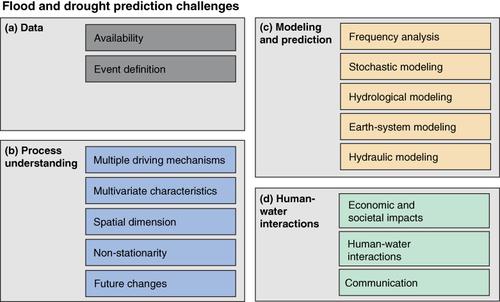当前位置:
X-MOL 学术
›
WIREs Water
›
论文详情
Our official English website, www.x-mol.net, welcomes your
feedback! (Note: you will need to create a separate account there.)
Challenges in modeling and predicting floods and droughts: A review
WIREs Water ( IF 6.8 ) Pub Date : 2021-03-11 , DOI: 10.1002/wat2.1520 Manuela I. Brunner 1 , Louise Slater 2 , Lena M. Tallaksen 3 , Martyn Clark 4
WIREs Water ( IF 6.8 ) Pub Date : 2021-03-11 , DOI: 10.1002/wat2.1520 Manuela I. Brunner 1 , Louise Slater 2 , Lena M. Tallaksen 3 , Martyn Clark 4
Affiliation

|
Predictions of floods, droughts, and fast drought‐flood transitions are required at different time scales to develop management strategies targeted at minimizing negative societal and economic impacts. Forecasts at daily and seasonal scale are vital for early warning, estimation of event frequency for hydraulic design, and long‐term projections for developing adaptation strategies to future conditions. All three types of predictions—forecasts, frequency estimates, and projections—typically treat droughts and floods independently, even though both types of extremes can be studied using related approaches and have similar challenges. In this review, we (a) identify challenges common to drought and flood prediction and their joint assessment and (b) discuss tractable approaches to tackle these challenges. We group challenges related to flood and drought prediction into four interrelated categories: data, process understanding, modeling and prediction, and human–water interactions. Data‐related challenges include data availability and event definition. Process‐related challenges include the multivariate and spatial characteristics of extremes, non‐stationarities, and future changes in extremes. Modeling challenges arise in frequency analysis, stochastic, hydrological, earth system, and hydraulic modeling. Challenges with respect to human–water interactions lie in establishing links to impacts, representing human–water interactions, and science communication. We discuss potential ways of tackling these challenges including exploiting new data sources, studying droughts and floods in a joint framework, studying societal influences and compounding drivers, developing continuous stochastic models or non‐stationary models, and obtaining stakeholder feedback. Tackling one or several of these challenges will improve flood and drought predictions and help to minimize the negative impacts of extreme events.
中文翻译:

洪水和干旱建模和预测中的挑战:回顾
为了制定旨在最小化负面社会和经济影响的管理策略,需要在不同的时间尺度上进行洪水,干旱和快速的旱涝过渡的预测。每日和季节性尺度的预测对于预警,水力设计事件频率的估计以及对未来条件的适应策略的长期预测至关重要。尽管可以使用相关方法研究两种极端情况并面临类似挑战,但所有三种类型的预测(预测,频率估计和预测)通常独立地处理干旱和洪水。在本文中,我们(a)确定干旱和洪水预报及其联合评估所面临的共同挑战,并(b)讨论应对这些挑战的可行方法。我们将与洪水和干旱预测有关的挑战分为四个相互关联的类别:数据,过程理解,建模和预测以及人与水的相互作用。与数据相关的挑战包括数据可用性和事件定义。与过程相关的挑战包括极端因素的多变量和空间特征,非平稳性以及极端因素的未来变化。建模挑战出现在频率分析,随机,水文,地球系统和水力建模中。人与水相互作用的挑战在于建立与影响的联系,代表人与水的相互作用以及科学交流。我们讨论了应对这些挑战的潜在方法,包括利用新数据源,在联合框架中研究干旱和洪水,研究社会影响力并加重驱动因素,建立连续的随机模型或非平稳模型,并获得利益相关者的反馈。解决其中一个或几个挑战将改善洪水和干旱的预测,并有助于最大程度地减少极端事件的负面影响。
更新日期:2021-04-02
中文翻译:

洪水和干旱建模和预测中的挑战:回顾
为了制定旨在最小化负面社会和经济影响的管理策略,需要在不同的时间尺度上进行洪水,干旱和快速的旱涝过渡的预测。每日和季节性尺度的预测对于预警,水力设计事件频率的估计以及对未来条件的适应策略的长期预测至关重要。尽管可以使用相关方法研究两种极端情况并面临类似挑战,但所有三种类型的预测(预测,频率估计和预测)通常独立地处理干旱和洪水。在本文中,我们(a)确定干旱和洪水预报及其联合评估所面临的共同挑战,并(b)讨论应对这些挑战的可行方法。我们将与洪水和干旱预测有关的挑战分为四个相互关联的类别:数据,过程理解,建模和预测以及人与水的相互作用。与数据相关的挑战包括数据可用性和事件定义。与过程相关的挑战包括极端因素的多变量和空间特征,非平稳性以及极端因素的未来变化。建模挑战出现在频率分析,随机,水文,地球系统和水力建模中。人与水相互作用的挑战在于建立与影响的联系,代表人与水的相互作用以及科学交流。我们讨论了应对这些挑战的潜在方法,包括利用新数据源,在联合框架中研究干旱和洪水,研究社会影响力并加重驱动因素,建立连续的随机模型或非平稳模型,并获得利益相关者的反馈。解决其中一个或几个挑战将改善洪水和干旱的预测,并有助于最大程度地减少极端事件的负面影响。











































 京公网安备 11010802027423号
京公网安备 11010802027423号